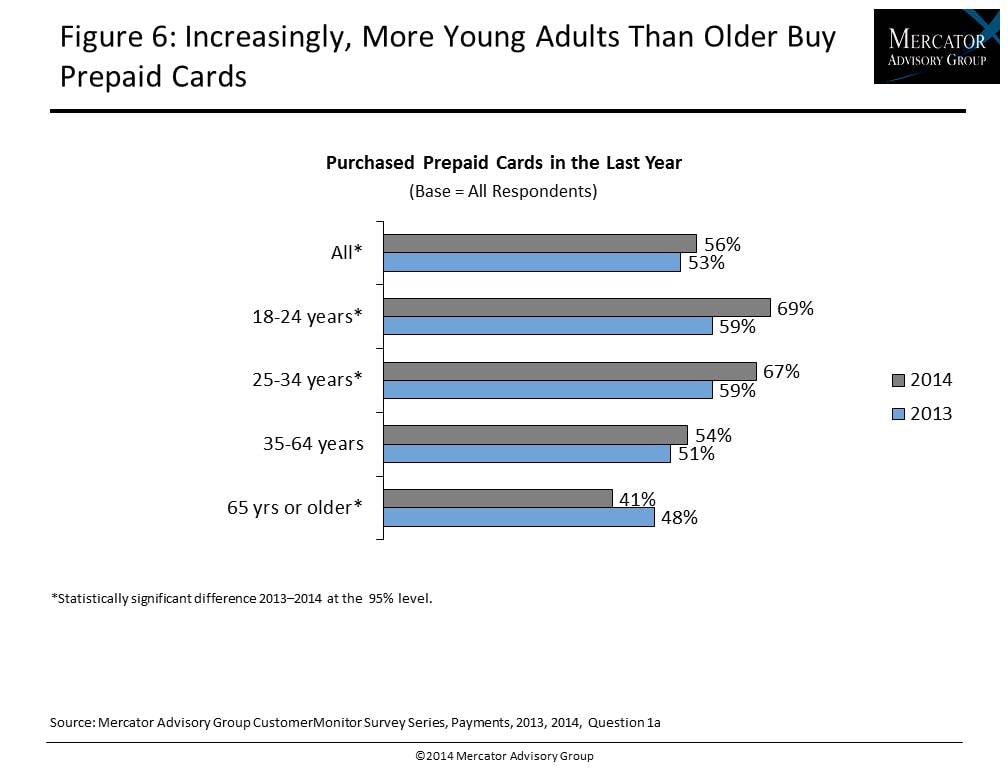Consumers and Prepaid: Rising Use, Especially by Mobile
- Date:December 15, 2014
- Author(s):
- Karen Augustine
- Research Topic(s):
- North American PaymentsInsights
- PAID CONTENT
Overview
Mercator Advisory Group’s most recent Insight Summary Report from the CustomerMonitor Survey Series reveals that 56% of U.S. adults bought prepaid cards in year preceding the 2014 survey, up from 53% in 2013 and 47% in 2012. Prepaid buyers are increasingly younger: 2 in 3 young adults (aged 18–34) surveyed bought prepaid cards, up from 3 in 5 surveyed in 2013. And they are increasingly mobile enabled, as nearly 2 in 3 smartphone owners, 3 in 4 smartphone and tablet owners, and 9 in 10 adults who have paid for goods and services by mobile phone have bought prepaid cards within the previous year. Today, prepaid cards are often a primary payment vehicle for mobile payments.
Consumers and Prepaid: Rising Use, Especially by Mobile, a report from Mercator Advisory Group, presents survey findings based on responses to an online survey of 3,002 U.S. adults conducted in June 2014 as part of the CustomerMonitor Survey Series. The report examines a demographic shift of prepaid card and virtual card buyers and the changing landscape of prepaid card use and recalled loads, highlighting seven categories of prepaid card types. Survey findings cover usage, frequency, distribution channels, the relative importance of feature sets and fees, and brand awareness and current or previous use of 10 major brands of general purpose reloadable (GPR) cards, as well as awareness that these GPR cards can be reloaded or funded through direct deposit.
Prepaid cards are now far more than just gift cards, according to the 2014 survey data, which finds more consumers receiving funds on prepaid cards as incentives, rebates, refunds, and even payroll and money transfers than in previous years. Consumers surveyed indicate they want a prepaid card that offers the conveniences of a bank account, including mobile apps, electronic bill payment, high-quality customer service, alerts, easy access to reloading, and fraud protection as well as ways to gain rewards—all with low setup and maintenance fees.
The two fastest growing segments of prepaid are open-loop gift cards in the form of general purpose nonreloadable gift cards and general purpose reloadable cards. T the purchase demographics are changing, with open loop gift cards are no longer bought more often by lower income earners. Today, higher-income earners (household income $100,000 or more) are more likely to buy GPR cards than in previous years. Mercator Advisory Group expects that as open-loop prepaid cards become more ubiquitous and begin to offer more services once provided only by financial institutions, prepaid cards will be more broadly used by U.S. consumers as a money management tool, especially for their privacy, convenience, and enhanced security.
“Even if they have a checking account, many U.S. consumers are attracted to prepaid cards as a money management tool that lets the cardholders control their spending and make electronic payments from funds they set aside, without accruing debt from credit cards or attaching their bank account to the transaction,” states Karen Augustine, manager of CustomerMonitor Survey Series at Mercator Advisory Group and the author of the report. “Prepaid buyers are more likely to be younger, mobile-enabled, and are more attracted now by enhanced security and mobile banking features.”
The report is 60 pages long and contains 29 exhibits
Companies mentioned in this report are: American Express, Chase, Green Dot, H&R Block, NetSpend, PayPower, Rush, and Walmart.
Members of Mercator Advisory Group CustomerMonitor Survey Series Service have access to this report as well as the upcoming research for the year ahead, presentations, analyst access, and other membership benefits.
One of the exhibits included in this report:

Highlights of this survey and report include:
- Year-over-year trending of prepaid card use by seven categories of prepaid cards (including retailer-specific, general purpose and reloadable cards) and consumers’ recollection of cards purchased and monthly load volume
- Shifts in the demographics of prepaid card and virtual card users, the ways consumers are using them, and the factors motivating preferences in distribution channels
- Importance of rewards to drive prepaid card purchases
- Use of online gift card exchanges
- Purchase behavior regarding GPR cards, including length of time card is in use, load frequency, and awareness and use of direct deposit to GPR cards
- Brand awareness, purchase, timing, and current use of 10 GPR card brands
Book a Meeting with the Author
Related content
A Generational Look at Card Network Usage
In this Primary Data Snapshot by Javelin Strategy & Research, a dive into year-over-year usage of the four major U.S. credit card networks shows that generationally targeted approa...
The Bots are Coming: Generational Aspects to AI Adoption
This Primary Data Snapshot—a Javelin Strategy & Research report focusing on consumer payment usage and behavior—shows how consumers, particularly younger ones, are leveraging the p...
2025 North American PaymentInsights: U.S.: Financial Services and Emerging Technologies Exhibit
This report is based on Javelin Strategy’s North American PaymentsInsights series’ annual survey. A web-based survey was fielded between July 14 – 26, 2025, using a US online consu...
Make informed decisions in a digital financial world